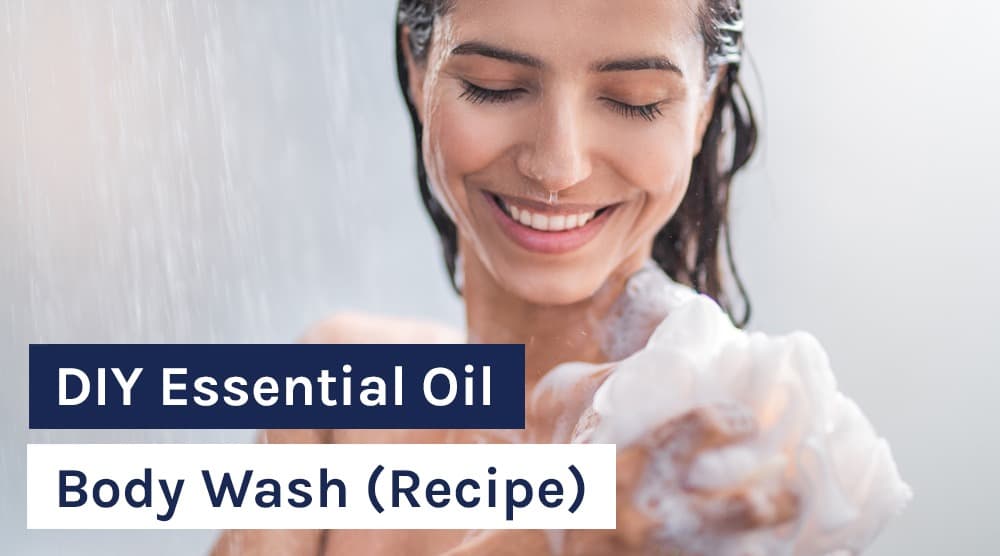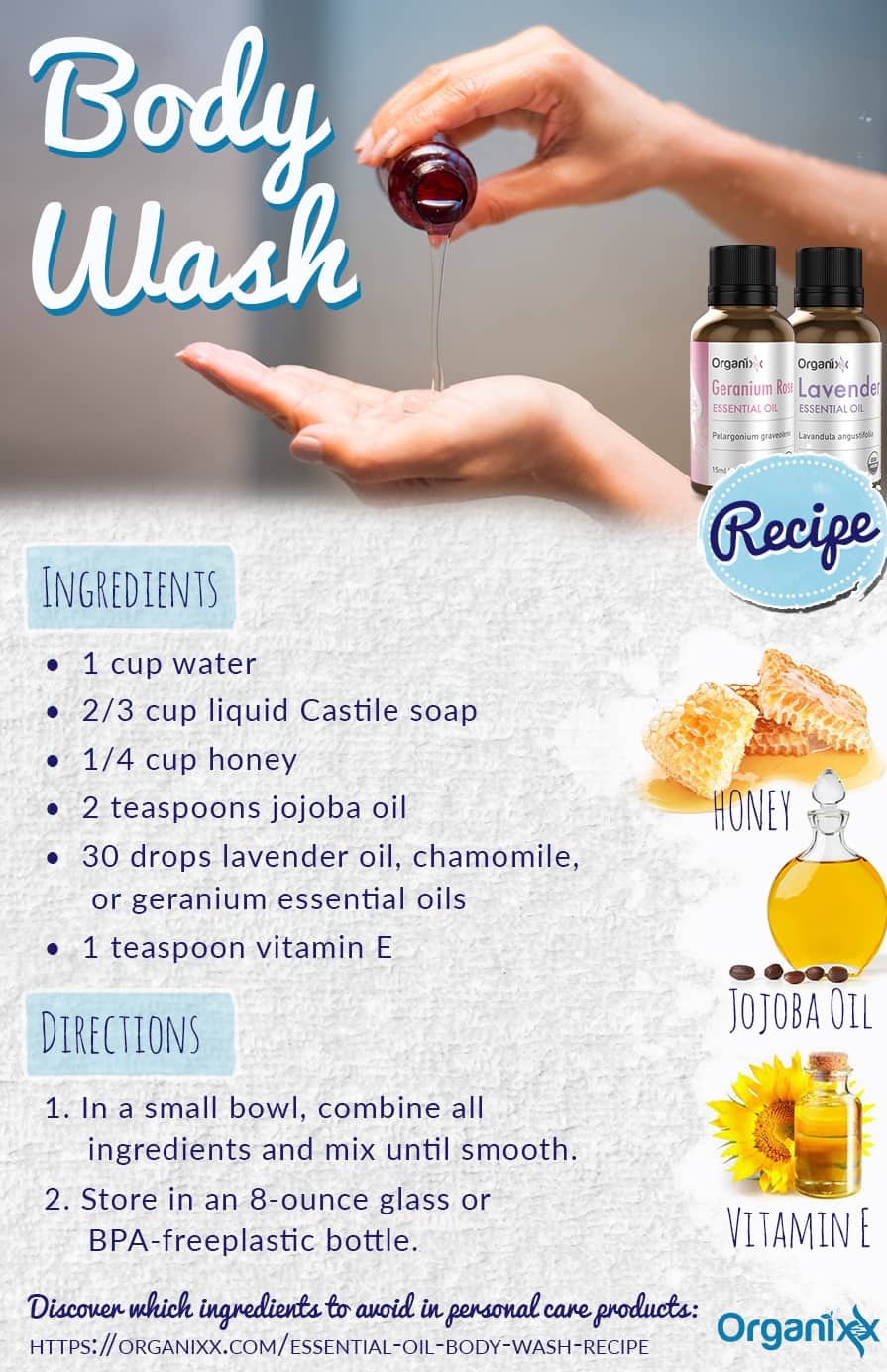DIY Essential Oil Body Wash Recipe
Ingredients
- 1 cup distilled water
- 1⁄4 cup honey
- 2/3 cup liquid Castile soap
- 30 drops lavender essential oil or geranium rose essential oil (or other favorite essential oil or blend)
- 1 teaspoon vitamin E
- 2 teaspoon jojoba oil
Instructions
- In a small bowl, combine all ingredients and mix until smooth.
- Store in an 8-ounce glass or BPA-free plastic bottle.
Notes
*Test sensitivity to the essential oils on a small patch of skin before using all over body
Personal care products… those products we use everyday to keep ourselves smelling fresh and clean. Unfortunately, many of the well-known brands lining store shelves have a hidden secret… they’re full of toxic, health-harming chemicals!
In a talk delivered at the Harvard School of Public Health in 2014, audience members learned that “In the United States, the average person is exposed to more than a hundred chemicals from cosmetics, soaps, and other personal care products before leaving the house in the morning [1].”
Avoid These Ingredients in Your Body Wash
The Campaign for Safe Cosmetics is a watchdog coalition of groups dedicated to eliminating harmful chemicals in personal care products. On their website they share information with consumers on the health-harming chemicals found in personal care products.
Here’s a quick list of common soap and body wash ingredients they say you should actively avoid…[2]
- 1,4-dioxane is a contaminant linked to cancer found in products that create suds, such as shampoo and liquid soap. On the label look for: Sodium laureth sulfate, PEG compounds, chemicals that include the clauses xynol, ceteareth, and oleth.
- Coal tar is a known carcinogen found in shampoos, soaps, hair dyes, and lotions. On the label look for: Coal tar solution, tar, coal, carbo-cort, coal tar solution, coal tar solution USP, crude coal tar, estar, impervotar, KC 261, lavatar, picis carbonis, naphtha, high solvent naphtha, naphtha distillate, benzin B70, and petroleum benzin.
- Formaldehyde and formaldehyde-releasing preservatives are often found in shampoos and liquid baby soaps. On the label look for: Formaldehyde, quaternium-15, DMDM hydantoin, imidazolidinyl urea, diazolidinyl urea, polyoxymethylene urea, sodium hydroxymethylglycinate, 2-bromo-2-nitropropane-1,3-diol (bromopol), and glyoxal.
- Fragrance – Many products list “fragrance” on the label, but very few name the specific ingredients which prevents consumers from knowing the full list of ingredients in their products. On the label look for: Fragrance, perfume, parfum, aroma.
- Methylisothiazolinone (MIT) and Methylchloroisothiazolinone (CMIT) are common preservatives are found in many liquid personal care products, and have been linked to lung toxicity, allergic reactions, and possible neurotoxicity. On the label look for: Methylisothiazolinone (MIT): 2-methyl-4-isothiazoline-3-one, Neolone 950 preservative, MI, OriStar MIT and Microcare MT. Methylchloroisothiazolinone (CMIT): 5-Chloro-2-methyl-4-isothiazolin-3-one, and MCI.
- Nitrosamines are impurities that can show up in a wide array of cosmetics ingredients. Nitrosamines are usually not listed on product labels because they are impurities, but on the label look for: DEA and TEA.
- Phenoxyethanol is a preservative in cosmetic products and a stabilizer in perfumes and soaps. Reaction to exposure to phenoxyethanol can range from eczema to severe, life-threatening allergic reactions. On the label look for: Phenoxyethanol, 2-Phenoxyethanol, Euxyl K® 400 (mixture of Phenoxyethanol and 1,2-dibromo-2,4-dicyanobutane), and PhE.
- Parabens are preservatives used in a range of products including shampoos, conditioners, lotions, facial and shower cleansers and scrubs. On the label look for: Ethylparaben, butylparaben, methylparaben, propylparaben, isobutylparaben, isopropylparaben, and other ingredients ending in –paraben.
- Pthalates are chemicals linked to endocrine disruption, developmental and reproductive toxicity, and cancer. While banned in cosmetics in the European Union, they still remain prevalent in U.S. products. On the label look for: phthalate, DEP, DBP, DEHP, and fragrance.
- Talc (which is found in some body and shower products) may contain the known carcinogen asbestos. Talc should be avoided in powders and other personal care products unless it is known to be asbestos-free. Even asbestos-free talc should be avoided in the pelvic areas. On the label look for: Talcum powder and cosmetic talc.
- Triclosan is an antimicrobial agent found in a wide variety of antibacterial soaps and other products that is linked to endocrine disruption, triclosan-resistant bacteria, and environmental toxicity. On the label look for: Triclosan (TSC) and triclocarban (TCC).
Healthier Alternative: Make Your Own Essential Oil Body Wash
If you love the feeling of lathering up with a sweet smelling body wash, here’s an easy recipe you can make at home. This body wash uses castile soap as a base, which is one of the safest commercially-available soap options. A good choice is Dr. Bronner’s unscented liquid castile baby soap which you can then scent with your favorite quality essential oils.





Water and oil do not mix.
What is the shelf life of this wash?
Hi Joy,
Thanks for your interest.
DIY Body wash is generally oil and Castile soap. So, you’re looking at 3–6 months, depending on the shelf life of the oil you use.
Always, keep an eye out for mold, change in odor, or a weird consistency. If anything seems off, toss it out and create a fresh batch, no matter what the shelf life is supposed to be.
We hope you decide to give this fabulous DIY Body Wash Recipe a try and wish you a happy & healthy day.
Can i make this diy for commercial purposes?
Hi Somadina, thanks for your question.
This is a fantastic DIY Essential Oil Body Wash that you can use for your own personal use. Our DIY Body Wash uses castile soap as a base, which is one of the safest commercially available soap options. A good choice is Dr. Bronner’s unscented liquid Castile baby soap which you can then scent with your favorite quality essential oils.
Feel free to give it a try and let us know what you think. Thanks so much for being here with us. Hope you have yourself a wonderful day!
Does the soap lather well? If not is there something I can add to help?
Yes, it sure does, Trolonda Sellers. Thanks for your question.
If you love the feeling of lathering up with a sweet-smelling body wash, then we would love for you to give our DIY Essential Oil Body Wash a try.
Our body wash uses castile soap as a base, which is one of the safest commercially available soap options. A good choice is Dr. Bronner’s unscented liquid Castile baby soap which you can then scent with your favorite quality essential oils.
Do let us know if you decide to give this fantastic body wash recipe a try. We'd love to hear how it turns out for you.
Thanks so much for being here with us. Hope you have yourself a wonderful day!
Can you use any kind of honey?
Hi Dawn East, thank you for your question and interest.
Raw or unfiltered honey is always the preferable option. Raw honey is a well-known skin soother that moisturizes your skin, heals your marks or scars on the skin, restores the elasticity, and prevents germs with its antibacterial properties.
We hope this helps. Do let us know if you decide to give this recipe a try. We'd love to hear how it turns out for you.
Thank you so much for being here with us. Wishing you a lovely day!